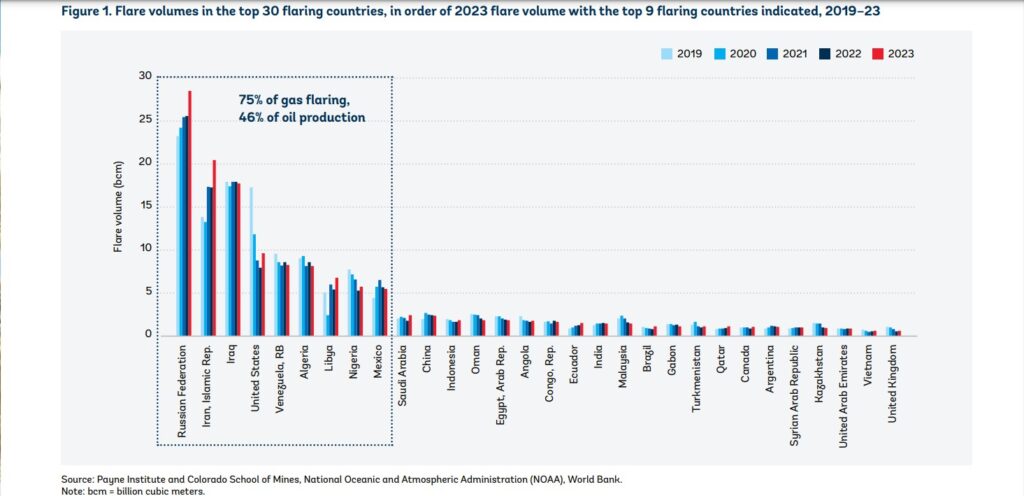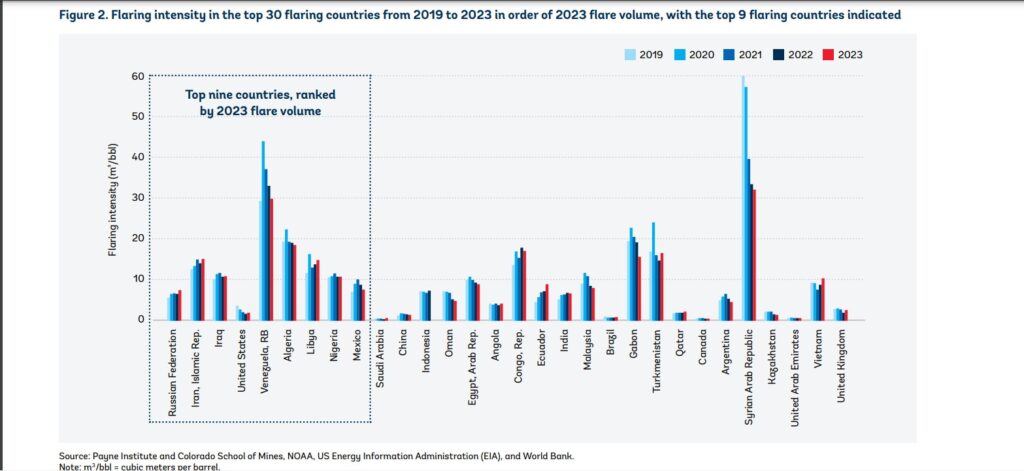- Nigeria ranked 8th in the Global Gas Flaring Tracker for 2023.
- Russia has seen a steady increase in gas flaring volumes since 2019, while Algeria and República Bolivariana de Venezuela achieved rising reductions in gas flaring.
The World Bank, in its latest Global Gas Flaring Tracker Report, has listed the top nine gas-flaring countries in 2023. According to the report, these countries have been leading in global gas flare volumes for over a decade.
The countries, which include the Russian Federation, the Islamic Republic of Iran, Iraq, the United States, República Bolivariana de Venezuela, Algeria, Libya, Nigeria, and Mexico, are responsible for 75 per cent of global gas flaring.
However, these countries account for just 46 per cent of global oil production. Over 60 countries comprise the remaining 25 per cent of global gas flare volumes.
Most of the gas flared globally is associated gas (produced in association with crude oil). Flaring intensity, the volume of gas flared in cubic meters per barrel of oil produced, is calculated at a country level. Over time, it indicates how well that country is doing in recovering and utilising associated gas.
According to the chat below, Russia has seen a steady increase in gas flaring volumes since 2019; meanwhile, Algeria and República Bolivariana de Venezuela achieved rising reductions in gas flaring.

The most significant increases in 2023 occurred in four of the top nine flaring countries: the Islamic Republic of Iran, Russia, the United States, and Libya.
These countries accounted for 9 bcm of additional gas-flaring. In addition to increases in flare volume, these countries also experienced an increase in flaring intensity.
Flaring increased by 11 per cent in Russia, the top flaring country in the world. For the United States, the Islamic Republic of Iran, and Libya, flaring increased by 21, 19, and 25 per cent, respectively.
Countries affected by fragility, conflict, and violence, such as the Syrian Arab Republic and República Bolivariana de Venezuela, account for the highest flaring intensity, although both have shown a steady improvement in flaring intensity over the past few years.
Flaring intensity is also high in some other oil-producing countries, such as Gabon, Turkmenistan, and the Republic of Congo, which suggests there may be opportunities to implement measures to recover and utilise associated gas in these countries.
Among the top nine flaring countries, flaring intensity has increased in Russia, the Islamic Republic of Iran, Iraq, the United States, and Libya. It has remained largely the same in Nigeria and has decreased in República Bolivariana de Venezuela, Algeria, and Mexico.

Global gas flaring increased by 9 billion cubic meters (bcm) in 2023, reaching 148 bcm, the highest level since 2019.
The World Bank has developed a novel approach to detecting unlit flaring and attributing methane emissions to such events, illustrated by a case study in this report.
With further refinement, countries could use this approach to assess the prevalence of unlit flaring globally and provide operators with early warning of potential unlit flaring events.
The World Bank and the Colorado School of Mines estimate flare gas volumes from individual oil and gas facilities worldwide based on the satellite-mounted Visible Infrared Imaging Radiometer Suite of detectors (VIIRS) Nightfire data.
Over the years, both organisations have collaborated to develop advanced algorithms to distinguish flaring from other hot sources and to estimate flare volumes, considering atmospheric conditions such as cloud cover.
Recommendations
The report recommends an urgent need to mobilise and renew political will and leadership, coupled with industry investments and improved practices across the world, to take critical action on several fronts, including,
1). Rapidly accelerate flaring reduction progress in the top nine flaring countries.
2). Urgently implement and kick-start investment plans to accelerate the flaring reduction essential to reducing global greenhouse gas emissions from the oil and gas industry.
3). Prioritise investment in associated gas recovery and utilisation when planning, designing, and operating oil and gas infrastructure to keep Zero Routine Flaring by 2030 within reach.
4). While gas flaring persists, minimise methane emissions by ensuring flares are lit and operating effectively.
5). Ensure that oil and gas operators can access financing and technical support to reduce gas flaring in countries with a weaker regulatory environment or where gas value chains are underdeveloped.
6). Promote the best practices of managing oil (and associated gas) production within the handling capacity of existing gas infrastructure, particularly during periods of reduced infrastructure capacity, to avoid a rapid accumulation of nonroutine gas flaring.
7). Design oil and gas infrastructure and emission reduction projects to better withstand the physical impacts of climate change hazards.
8). Leverage existing collaboration between public and private sectors to enable the widespread adoption and implementation of effective regulations.